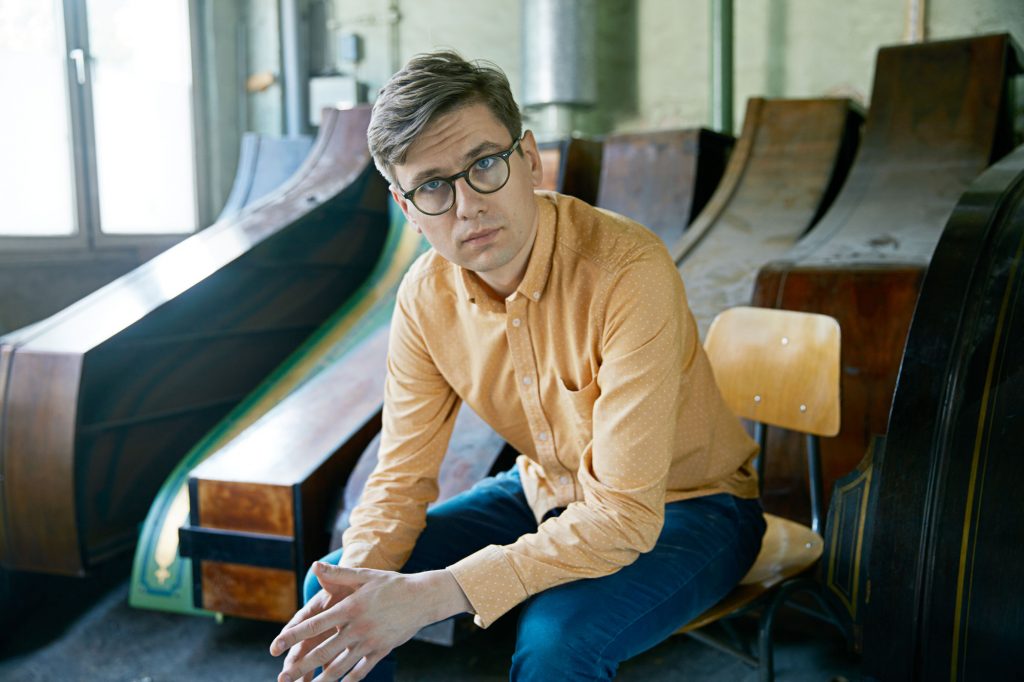BOWL OVER BEETHOVEN
Last night at the Hollywood Bowl started off with a bang. British composer and guest conducter Thomas Adès began an evening of “Beethoven Masterpieces” — with Iceland’s Víkingur Ólafsson offering the Second Piano Concerto — with a rendition of “The Star-Spangled Banner” that was decidedly awesome: more rhythmic and decisive than any I have heard at the Bowl. That’s because it came courtesy of Igor Stravinsky. Unfortunately, it turned out to be one of the most interesting things of the night.
Stravinsky did indeed arrange the U.S. national anthem (four arrangements of Key’s anthem, actually, but that’s another story) but it wasn’t controversial because of its modern harmonization: The first draft was completed on the eve of WWII (July 1, 1941), and Stravinsky subsequently performed it in concerts across America – but he was a Russian émigré and you can imagine the suspicions that Americans had towards all things USSR during and after the war. (Since twelve Russian intelligence officers were accused last Friday of trying to interfere in the 2016 presidential elections, including a hack of Democratic National Committee, suspicions are no doubt back on the table).
In 1944, a year before the composer became a U.S. citizen, he had planned his arrangement to be played with the Boston Symphony; he was threatened with a $100 fine for violating a state of Massachusetts ordinance for arranging the anthem in a non-traditional manner. Since the parts were seized from the music stands to prevent them being used for a radio broadcast, Stravinsky conducted a more traditional arrangement (the rumor that he was arrested has never been substantiated).
The first piece in this underwhelming program was by Adès himself: a 2007 tone poem about the story of Noah’s Ark called Tevot (tey-VA), which is Hebrew for “bars of music” and also means “ark” in the Bible. Adès may have been going for a one-movement symphony here, but it’s more like Pop Trance, that music from the 80s — usually electronic — that builds tension with a series of peaks and drops throughout, liberally incorporating influences from other musical styles.
And right out of the gate of this 24-minute piece is signs of Stravinsky. That slow-building tension occurring at the onset of the Rite of Spring — which inspired Disney’s artists to imagine the world’s beginnings in Fantasia — happens here as well, but with more complexity as the iridescence flares up into spirited interactions. The Maestro told us what to listen for beforehand: From quiet to torrential rain and flood, setting sail for safe haven, and finally landing as the pairs descend to (my words) pee, poop, and propagate. We were also told that we would hear 25 anvils in the percussion section representing the building of the ark.
What we actually get is a sequence of suspensions broken up by crammed clusters of notes, scattered with other phrases that feel devoid of meaning, so it doesn’t conjure up images like Stravinsky can. Obviously, there are mesmerizing moments, such as the New World being represented by strings and woodwinds gently swaying, ever-building, with high discordant flutes, but then it would be back to organized chaos.
Adès is not going for the development of a motif here, and you won’t get a sense of phrase, timing, or harmonic motion. It’s not remotely lyrical, and I had trouble wrapping my brain around this journey. This series of soundscapes is both inventive and evocative, but you either like this stuff or you don’t — and I never need to hear it again. While I suspect that “new music” lovers — you know, graduates of Cal Arts and their professors — will drool over Adès’s use of chromatic descents and non-harmonics, I agree with a comment from someone else: “Sounds like something from Holst’s The Planets played backwards on acid.”
Written when he was 14 (“stretching his wings,” per Adès), Beethoven shows his debt to Mozart (and Haydn, though he would not acknowledge it) while asserting his own personality in the opening of the Piano Concerto No. 2 in B-flat major, even before the entry of the soloist (Concerto No. 2 was actually Beethoven’s first to be written). Once Ólafsson began, he tended to stress the Mozartian qualities rather than the Beethovenian. Wearing a suit and bespectacled with short, styled, dirty-brown hair, the tall thin pianist looked more like an English Major student about to give a dissertation, which is perfect for this rather dry rendering. Most impressive technically were his sweet pianissimo passages and runs as he tenderly hunched over the keys, but there was no emotional fire in his playing or his face, save the occasional flourish and emphasis at the end of a phrase, and during the more exciting third movement.
As a technician, he’s flawless and meticulous, with incredibly long fingers that looked like gregarious dancing spiders as they flowed over the keys, but I think a) Ólafsson seems better-suited for Bach or Philip Glass and b) this was a wrong choice for the Bowl. That’s a lot of space to electrify, and it’s not the most electrifying concerto, so any wattage has to come from the pianist and an equally meticulous conductor, which Adès was not more than a few times.
At least with the Seventh Symphony — which can be called a “masterpiece” whereas the Concerto is not (unless you consider everything Beethoven wrote a masterpiece) — Adès was in an inquisitive mode, especially when he played with light and dark in the second movement, which he took from gloriously reverent and still to gorgeous and stately. He really played with conventions in the third, finding new moments and pace that I’ve never heard. Wearing a white tux, he vigorously and triumphantly brought it home. While there were surprising moments, the overall arc never fully enveloped me the way that Dudamel does with Beethoven at the Bowl.
photos courtesy of LA Phil
Los Angeles Philharmonic
Thomas Adès, conductor
Víkingur Ólafsson, pianist
The Hollywood Bowl, 2301 N. Highland Ave.
played Tuesday July 17, 2018, at 8pm
for more events, call 323.850.2000 or visit The Hollywood Bowl



